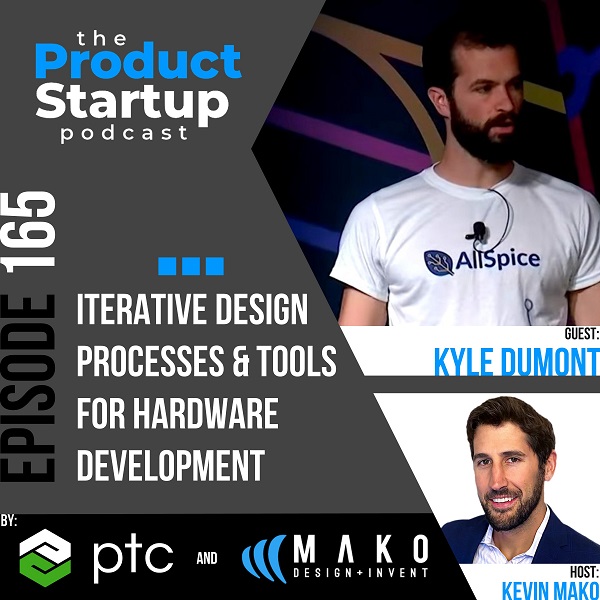With Kyle Dumont, Founder of AllSpice.io
Hosted by Kevin Mako, President of MAKO Design + Invent

Kyle Dumont spent several years working as a hardware developer for iRobot before pursuing a dual degree at Harvard University, a Master of Science, and an MBA. After completing his education, he founded AllSpice, a software platform that offers various functions including assisting with electronic engineering feedback and revision tracking. Kyle now wishes to share his expertise on the iterative hardware product development process with inventors, startups, and small manufacturers. He will discuss the importance of the feedback loop stakeholders and offer guidance on how to gather, organize, prioritize, and implement iterative feedback information to ensure the most effective enhancements to your physical consumer product design.
Today you will hear us talk about:
- The process of making changes and improvements to a product design between manufacturing runs is known as iterative hardware design.
- While legacy design follows a waterfall model, software design has effectively utilized iterative design.
- Facilitate iterative design by putting designs in the hands of engineers or users involved in the design process.
- Implement iterative design processes to prepare for unexpected changes that may arise during the product development lifecycle.
- The stakeholders involved in iterative design include current and potential customers, cost reduction, various engineering disciplines, procurement, product managers, and manufacturers.
- Gain valuable feedback and insights by engaging hardware engineers with customers.
- Version control is a tool that serves as a foundation for organizing and tracking changes, which can be used along with other tools to collect, organize, prioritize, and implement feedback.
- Compare versions of the design to identify changes and improvements during the iterative design process.
- Ensure that channels and tools are available for all product stakeholders to provide input.
- Integrate different tools to ensure that all stakeholders have access to the most comprehensive information during the iterative design process.
- Prevent silos between departments by sharing information and promoting collaboration during the iterative design process.
- Use priority flagging to indicate the importance of issues or opportunities during the iterative design process.
EPISODE HIGHLIGHTS
- 1:00 – Hardware is now developed iteratively, but there are tools to do it the best way in 2023
- 3:00 – Hardware product development iteration is historically rigid and difficult
- 3:15 – Ideally you want to be nimble and be able to meet customer demand, or other market demands.
- 4:30 – What is iterative design between manufacturing runs?
- 4:40 – Legacy hardware design is through waterfall methodologies. Releases are planned well in advance and thus iterative design and feedback is very rigid.
- 5:00 – Modern hardware development takes from the software playbook
- 5:25 – It is easier than ever, due to manufacturing technology, to get iterative designs back to review and improve. More confidence to iterative and move forward with a new design.
- 5:30 – Quick assemblies, 3D printing, low quantity builds, short run manufacturing
- 6:00 – The pandemic forced people to be agile in development given that many supply chain issues forced legacy processes to upgrade to iterative design logic.
- 6:55 – There is a ton of new technology both in design and manufacturing to be able to iterate your product efficiently.
- 7:05 – Short run production is so valuable to iterative physical product design and development.
- 7:30 – Planning your product lifecycle well in advance is not realistic unless you can pay millions on consultants and data to ensure you’re properly making those predictions so early, and even so, the information will be weaker than iterating in real-time based on real market needs.
- 8:30 – There are many different stakeholders which should weigh into the feedback between each iterating in design: The customer, industrial design, mechanical engineering, electronics engineering, software, manufacturing, product managers, investors, the inventor, employees, etc.
- 8:50 – Make sure you get engineers in front of customers that have bought your prior versions of the product.
- 9:55 – Who are your existing customers and who are your potential customers.
- 10:10 – Feedback can be both problems that need to be solved but also opportunities for new features.
- 10:50 – Make sure you are at least first being sure that you are collecting feedback information.
- 11:00 – After you collect feedback information, how do you organize and prioritize that information, so that you can eventually execute on that information properly.
- 11:30 – A foundation of organization is revision control.
- 14:40 – Collaboration is the next key pillar of iterative design, built on the foundation of revision history.
- 17:00 – How do you then prioritize the collaborated information. Priority labels and importance.
- 19:00 – Even if you’re just a new hardware startup, you can use these processes in a simple spreadsheet to improve the output of your physical product development processes.
EPISODE LINKS
Kyle Dumont Links:
LinkedIn | AllSpice
The Product Startup Podcast Links:
https://www.ProductStartup.com/
Instagram | LinkedIn | Facebook Page | Facebook Group | Pinterest | Twitter | YouTube
PTC Links:
https://www.ptc.com/
OnShape | Creo
Mako Design Links:
https://www.makodesign.com/
YouTube | Instagram | LinkedIn | Facebook | Pinterest | Twitter
Kevin Mako Links:
Instagram | LinkedIn | Quora | Facebook | Twitter
Partner: PTC’s best-in-class software solutions Onshape: The only cloud-native product development platform that delivers full-featured computer-aided design (CAD), integrated product data management (PDM) and enterprise analytics in a single system, and Creo: 3D CAD solution that provides designers with the most innovative tools to build better products faster, such as generative design, additive manufacturing, real-time simulation, IIoT, and augmented reality.











